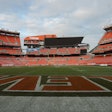All Rights Reserved
In the end, the old workhorse exhaled its last breath, sagged in the middle and collapsed with a silent and steady heave.
It took just 35 minutes Saturday to deflate the Metrodome's signature fabric roof, providing both a symbolic end of an era as well as a meaningful start to the construction on the new $1 billion Vikings stadium in its place.
By April, all traces of the Dome will be erased from the Minneapolis skyline, replaced by a glassy new behemoth in 2016.
The scheduled deflation went without a hitch, despite nagging worries about wind and adverse winter weather.
Minnesota Sports Facilities Authority Vice Chairman Bill McCarthy called it "a sad and exciting day at the same time. I don't want to forget what this building has meant to many of us, the Vikings, Twins and Gophers fans and the many high school and college games that have been played here."
MSFA officials, longtime employees and construction workers each turned off power to the fans that support the roof at 7:15 a.m. - a move that permitted the Dome's 10 acres of Teflon-coated fiberglass fabric to slowly sink. Relief vents were opened, as well as 10 exterior doors, as the deflation process began under gray, snowy skies.
When it was done, the 31-year-old stadium looked like a concave petri dish, rimmed with snow.
There was a bit of uncertainty attached to the task because the Dome's roof has never been deflated - intentionally. On four previous occasions, it collapsed after heavy snows and hurricane-force winds, most recently in 2010.
MSFA officials closely monitored the weather throughout the night. "We moved it up to do it as soon as we were ready," said Steve Maki, the authority's director of facilities and engineering. If winds had surged beyond 10 miles per hour, the deflation would have been delayed.
Officials had worried that stiff winds could have turned the roof into "a big sail," Maki said.
The roof fabric will be recycled by St. Paul-based excavator Frattalone Companies, which will use it for future construction projects.
Crews entered the Dome shortly after the deflation, tacking down the fabric and shearing off parts of it into four big pieces. The turf and most of the bright-blue seats had already been removed, leaving behind a kind of concrete shell.
Built in the early 1980s for $55 million - under budget - the utilitarian Dome was never beloved like its predecessor, Metropolitan Stadium in Bloomington.
But soon after the news came out Saturday that its roof was deflated, a few fans began memorializing it.
Atop a parking ramp overlooking the roofless dome, Julian Loscalzo and Tom Smith popped open a bottle of champagne, poured it into plastic-foam cups and toasted the Dome's demise.
"It was already outdated before it was built," said Loscalzo, who organized the "Save the Met" movement against the Dome in the late 1970s. "We were right."
The longtime friends hung their old homemade green sign that read "Save the Met" across the parking ramp roof as they tailgated with cigars and reminisced about how sports have changed in 33 years.
"You don't see any concrete doughnuts anymore," Smith said.
It was a bittersweet moment for the two, who fought hard against the Dome's construction but were still there for the Twins first game and many more after that. "The building was always kind of crappy, but the memories were good," Loscalzo said.
Across from the Dome at Huberts Bar & Grill, Linda Swendby of Fridley was one of the dozens of people packing the restaurant for the "Dome Deflation Party," celebrating over "roofless" burgers (without the top of a bun) and bottles of $1.50 beers, the price in 1982, the year the Dome opened.
"It's sad," said Swendby, who worked for 15 years at the Dome as a custodian and security employee. "It's just part of something that's been a landmark for years. It's history."
Construction has already begun on the new stadium with the excavation of a giant crater on the eastern side of the property to make way for the new structure's pilings.
Actual demolition of the Dome will begin Monday with the loading dock on its eastern side slated for the wrecking ball, said Dave Mansell, general superintendent of Mortenson Construction, the Golden Valley-based general contractor for the new stadium. As activity ramps up on the new stadium, the Minnesota Supreme Court is considering a last-minute legal challenge lodged by three Minneapolis residents over the way the public portion of the project is being funded. The state abruptly halted its scheduled sale of $468 million in bonds last week.
MSFA Chair Michele Kelm-Helgen said Friday she's confident the state and the authority will prevail.
Janet Moore · 612-673-7752
Kelly Smith · 612-673-4141
Terms and Conditions Privacy Policy



































